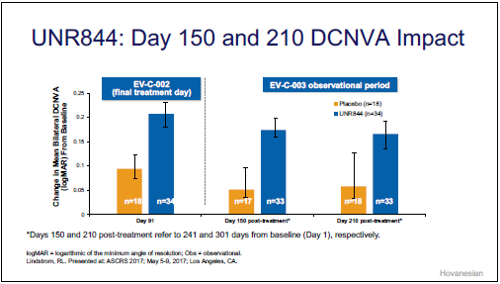Presbyopia
Lens-Softening Drug May Offer Presbyopia “Cure”
Phase 2 trials underway for eyedrops intended to restore some accommodation.

Howard Larkin
Published: Friday, September 30, 2022
Most approved or nearly approved presbyopia drugs work by inducing miosis to extend depth of focus. But the effects last a few hours at most and may interfere with night driving and low-light vision.
By contrast, the experimental compound UNR844 (lipoic acid/ choline ester 1.5% solution, Novartis) works not by affecting pupil size but by increasing the flexibility of the crystalline lens, theoretically restoring some accommodation. The resulting near add is pupil size-independent so it does not reduce incoming light—and the effect may last for months after a few weeks of treatment.
This is why John A Hovanesian MD sees UNR844, currently in phase 2b clinical trials, as a potential breakthrough in presbyopia treatment. “We want something safe, tolerable, and has long-term benefit, and that’s where this drug is unique,” he said.
DISSOLVING BONDS
The choline component of UNR844 is designed to help penetrate the cornea so the active ingredient, lipoic acid, can reach the aqueous humour and crystalline lens fibres. There, lipoic acid is hydrolysed and reduced into dihydrolipoic acid, which dissolves disulfide bonds thought to be a major contributor to lens stiffening. This also is thought to allow cytosol to again flow freely and may free bound proteins that stiffen the lens.
Theoretically, this restores lens flexibility, allowing it to change shape and accommodate. In a mouse model, lipoic acid significantly increased lens viscoelasticity, Dr Hovanesian noted.i
More to the point, the drug appears to work in humans. In a phase 2a study of UNR844 involving 72 patients, 52% of UNR844 patients gained 10 or more letters of distance corrected visual acuity (DCNVA) after 90 days of twice-daily installation compared with 20% of placebo patients. From baseline to day 91, UNR844-treated subjects demonstrated an improved mean DCNVA change of logMAR -0.159 compared with -0.079 (0.116) for the placebo group (p = 0.007).
Moreover, UNR844 patients maintained most of their near vision gains 150 and 210 days after they stopped treatment, demonstrating the durability of the drug’s effect.ii
The phase 2b study currently underway involves 600 patients. The primary endpoints are the percentage of patients gaining 10 or more letters of DCNVA and change in bilateral DCNVA from baseline.
A novel compound, UNR844 has the potential to work on patients with early cataract. While it is unlikely to reduce the need for eventual cataract surgery, it may be a semi-permanent
solution, he said.
“This is a drug that might actually cure presbyopia. So, it is a pretty exciting prospect for treating this common condition,” Dr Hovanesian concluded.
Dr Hovanesian presented his findings at the American Society of Cataract and Refractive Surgery 2022 Annual Meeting in Washington, DC, US.
i Investigative Ophthalmology & Visual Science. 2016; 57(6): 2851–63.
ii Lindstrom RL. ASCRS 2017; Korenfeld MS. Eye, 2021; 35: 3292–3301.
John A Hovanesian MD is in private practice at Harvard Eye Associates in Laguna Hills, California, US, and is a clinical instructor at Jules Stein Eye Institute, University of California–Los Angeles, US.

Latest Articles
Towards a Unified IOL Classification
The new IOL functional classification needs a strong and unified effort from surgeons, societies, and industry.
The 5 Ws of Post-Presbyopic IOL Enhancement
Fine-tuning refractive outcomes to meet patient expectations.
AI Shows Promise for Meibography Grading
Study demonstrates accuracy in detecting abnormalities and subtle changes in meibomian glands.
Are There Differences Between Male and Female Eyes?
TOGA Session panel underlined the need for more studies on gender differences.
Simulating Laser Vision Correction Outcomes
Individualised planning models could reduce ectasia risk and improve outcomes.
Need to Know: Aberrations, Aberrometry, and Aberropia
Understanding the nomenclature and techniques.
When Is It Time to Remove a Phakic IOL?
Close monitoring of endothelial cell loss in phakic IOL patients and timely explantation may avoid surgical complications.
Delivering Uncompromising Cataract Care
Expert panel considers tips and tricks for cataracts and compromised corneas.
Organising for Success
Professional and personal goals drive practice ownership and operational choices.